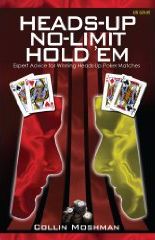Review: Heads-Up No-Limit Hold ’em: Expert Advice for Winning Heads-Up Poker Matches

Author: Collin Moshman
Publisher: 2+2
Cover price: $29.95
Pages: approx 386
Rating: 9/10
First of all, an acknowledgement that I have been coached by Collin in the past. Some of you will give me the benefit of the doubt and assume that I am still capable of submitting a balanced review. Those of you who know me better might suspect that free dinners have changed hands and to knock a full point off the rating accordingly.
I was hoping to wade through the dedications, acknowledgements and indices and get to chapter 1 which would start ‘If in doubt, go all-in. Most of the time they can’t call.’ Then a few tables and some graphs to support that hypothesis, a few quiz questions, my work would be done and the first ever 10/10 would have been awarded. Alas, it was not to be.
For SNG and cash players, heads-up is probably the fast-growing form of hold ’em. Prolific action exists at all levels and in all formats on all the major sites. But even if you don’t play strictly heads-up matches, Moshman is quick to point out that almost all players routinely rely on their heads-up skills. When everyone folds to the blinds in fuller games, these skills are suddenly put to the test. And if you’re trying to win it all in the final table of a major tournament, the final and most crucial step will be the heads-up battle for the bracelet and cash.
Moshman’s heads-up book starts with a list of preliminary concepts, including pot odds, showdown equity, fold equity, hyper-aggression, and value betting. If this is ‘poker filler,’ it isn’t excessive. He then discusses the relative advantages of tight-aggressive and loose-aggressive play, coming out in favour of the latter as the best style for most players. Of greatest value though, there is a thorough discussion of how to exploit the four most common playing styles. You will learn to value-bet relentlessly against loose-passive opponents, exploit tight play through betting and raising widely, and letting the maniacs hang themselves. Obvious enough, you might think, but it helps to see it in print and to think about all the times you have failed to do this.
The focus then switches to pot size manipulation, including the original and highly useful "Bets-per-hand Number." Cliff’s Notes: Know how big a pot you want to play, and have a specific strategy to achieve that pot size. While many authors discuss pot control in broad terms, the advice given here is very specific and should be useful to players from all backgrounds. This book has many sample hands played by pros, and the examples of Phil Helmuth‘s price-setting river bets in this section were some of the most interesting.
While the author advocates playing much looser on the button than from the big blind, there is a great discussion on deciding your best line after flat-calling a button raise. Donk betting, despite the name, can be a solid tool in any player’s arsenal, even if it is generally misused by bad players. Other isolated concepts include bluffing opportunities on the later streets, criteria for the river value raise, attacking button limps, and the stop ‘n go.
There are probably more tournament examples than cash examples in this book, although the section devoted to differences between these two styles is good. The table on p. 293 shows a common online heads-up tournament structure, and converts the blinds into what they would be in a cash game. Unlike normal tournaments, chips don’t decline in value, so there’s a linear conversion between tournament chips and their dollar values. As Moshman points out, cash and tournament are therefore much more similar formats in heads-up compared to full ring or 6-max.
The metagame, how current play is affected by previous play and will affect future play, is a much more important component of the information-saturated heads-up compared to fuller tables. Moshman starts with what should be an obvious point, but perhaps isn’t to many players: If you’re opponent is unobservant, you needn’t worry much about his perception of you. The most instructive example is that of button limping. One of the big reasons not to play literally on the button — raising your strong hands, and limping (or sometimes folding) your weak hands — is the exploitability of such a strategy. A loose-passive fish thinking on Level 0, however, is probably not engaging in active exploitation. Therefore if you think the best strategy against such players is a very literal and straightforward one, that is exactly how you should play.
Coming from a sit ‘n go background, I was surprised not to see even more coverage on short-stacked play from the author. Nonetheless the sections on this material are very solid, with a mixture of general strategy for short-stacks, along with several very useful charts on shoving and calling. He also goes over situations to limp or make smaller raises.
The final section focuses on Career Play. The material on Tilt Avoidance is excellent advice for people playing any game format, with the primary recommendation of verbalising the thought process. I would have thought the subjects of variance and bankroll requirements deserved more amplification in this section given their fundamental importance, but all things considered, this is a very good book.
Order Heads-Up No-Limit Hold ’em: Expert Advice for Winning Heads-Up Poker Matches from Amazon
